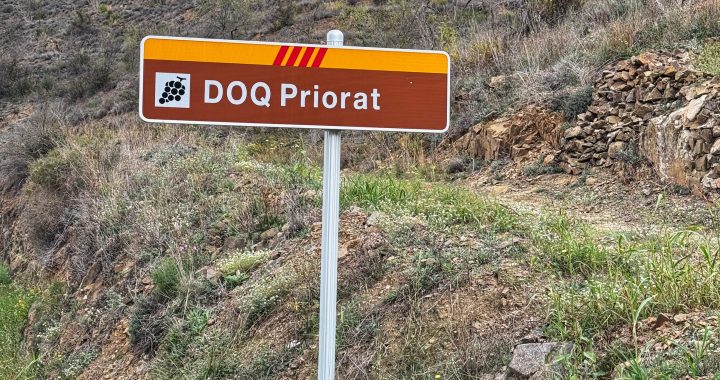Priorat is a wine region around a 2 hour drive east of Barcelona. It is only one of two DOCa (Denominación de Origen Calificada), the highest qualification for a wine region in Spain. Priorat is labelled as a DOQ (Denominació d'Origen Qualificada), whilst the other region in Spain is Rioja, which is labelled DOCa, but they both from a wine law perspective are the same.
Priorat DOQ is described by the locals as the “egg yoke” in a “fried egg”, with the “egg white” potions the Montsant DO which almost completely surrounds Priorat DOQ. I will also describe Priorat DOQ as a “basin” with the jagged terrain with a number of “peaks” formed over years of erosion. The “peaks” usually will host a small town where you can see neighbouring towns on the next “peaks” in the distant.
- Climate:
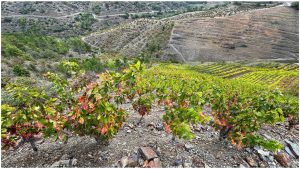 Priorat is located in Catalonia, which is on the east coast of Spain; which generally is an warm Mediterranean climate; however since Priorat DOQ is in a “basin”, carved out from millions of years of erosion, it has it’s own micro-climate which with long, hot and dry summers with little annual rainfall; which is by definition more of an continental climate. With the extreme steep slopes and various aspects (due to the landscape created by the natural erosion) the harvest time from the north (higher elevation) to the south (more flatter plains) can vary by months
Priorat is located in Catalonia, which is on the east coast of Spain; which generally is an warm Mediterranean climate; however since Priorat DOQ is in a “basin”, carved out from millions of years of erosion, it has it’s own micro-climate which with long, hot and dry summers with little annual rainfall; which is by definition more of an continental climate. With the extreme steep slopes and various aspects (due to the landscape created by the natural erosion) the harvest time from the north (higher elevation) to the south (more flatter plains) can vary by months - Grapes: Garnacha (this is the Spanish name for Grenache) and Cariñena (this is the Spanish name for Carignan), as they are late ripening grape varieties. Bordeaux blends such as Cabernet Sauvignon and Merlot are common too within the region when the “pioneers” introduced the grapes with new modern techniques. However during our visit (in Sept 2024), a majority of the wine makers are going back to the traditional varieties of Garnacha and Cariñena due to climate change and these traditional Priorat varieties more suited to the region
- Wine Style: Priorat is mainly known for its red wines, our experience (in Sept 2024) was not what we had expected based on the background research we had done. We found the wines in Priorat very elegant which was not heavy and full-bodied from the research we had done prior to going. From discussions with the wine makers and wineries we had, this perception of heavy and full-bodied wines is due to the introduction of the Bordeaux blend grapes by the “pioneers” in 1990’s, and where certain wine critics labels Priorat (for good or for bad) as this style of wines. However due to various factors such as climate change and traditional farmers that grew grapes for wineries now making their own wine and using the more traditional grapes and techniques the wines are now very elegant. What surprised us was how some wine makers can make a high tannin grape of Cariñena into a very elegant wine! There are still wine makers that still grow the Bordeaux blend and make heavier wines, but slowly they are becoming far and few between.
- Size and Yield: Priorat is a very small wine region with around 2,000 hectares under vine (Rioja, the other DOCa within Spain has around 60,000 hectares under wine). Due to the harsh climate and growing conditions, the yield in Priorat is very low with just 5 hectolitres per hectare1 (the worldwide average is around 50 hectolitres per hectare)
Winery
The various wineries are spread out within the Priorat DOQ with the Montsant mountains on one side, they are usually within or close by to one of the towns within Priorat, but note that driving between the towns are on small windy roads, so give yourself ample time for the commute.
Most of the wineries only take advance bookings for a wine tour, suggestion will be to go onto their website and make a booking (any payment) to secure a time. In general the wine tour will include an introduction of their winery which may include a walk into the vineyard and then followed by a wine tasting flight. I didn’t notice any wineries that had an “staffed” cellar door, meaning they may have a retail shop area but it was not staffed and ready for walk-in customers. The wine tours are very informative, the guides (or at times the wine maker or owner) can answer pretty much any question you have!
- Celler Scala Dei (map) - One of the larger wineries in the Priorat DOQ, you can book a tour where they will provide a history of the region, the winery and a tasting, a good all rounded tour and experience; they have an amazing maturation cellar with historical significance
- Celler Joan Ametller (La Morera de Montsant) (map) -
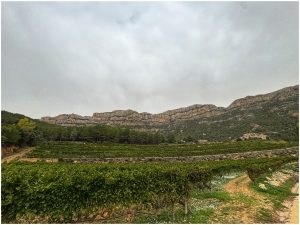 I think one of the most northern wineries, started with a short walk into their vineyard with the guide and her four legged colleague (who is very playful) and then wine tasting of a number of their wines; definitely worth the trip out there and you can following with a lunch at Quatre Molins
I think one of the most northern wineries, started with a short walk into their vineyard with the guide and her four legged colleague (who is very playful) and then wine tasting of a number of their wines; definitely worth the trip out there and you can following with a lunch at Quatre Molins - En Números Vermells (Gratallops) (map) - A very energetic and passionate wine maker named Silvia Puig, her family are native Priorat and were wine makers so she knows the area very well. She is also an artist as well, designing her own wine labels! We managed to get to try this winery through the guided day tour, so not sure if you can book direct! However her husband is the chef and owner at Brots Restaurant, maybe you can ask her husband for an introduction when you lunch or dinner at his restaurant (which you should go, food is very good and well priced)!
- Giol Porrera (Porrera)
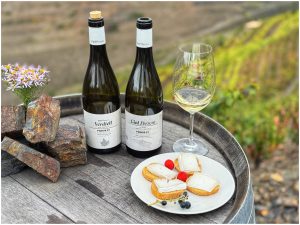 (map) - A local wine maker that has changed from providing fruits to other wine makers to keeping the best fruit for himself now and making his own wine which is very good! As he is a very small wine maker, we managed to meet him through the guided wine tour; but you can try to reach out to him but his English is not very strong.
(map) - A local wine maker that has changed from providing fruits to other wine makers to keeping the best fruit for himself now and making his own wine which is very good! As he is a very small wine maker, we managed to meet him through the guided wine tour; but you can try to reach out to him but his English is not very strong. - Atavus (Gratallops) (map) - They have a restaurant with amazing views, so worth to just go for a drink and / or meal; you can buy their wine from the restaurant.
Another option available is to book a “guided day tour”, where a local guide will pick you up from your hotel and will arrange and take you to a number of wineries in their vehicle. These guided day tours are expensive, and may not include lunch (but will have a stop for lunch) but it does save you from driving (hence you can taste more) and some of these wineries will be smaller local ones so maybe only way to do a tasting is via these guided day tours; also some of the local wine makers speak limited English so having a guide helps.
- Travel Priorat - Was a good day where our guide, Ania who speaks fluent English (as she is English) but has moved to the Priorat region; they will provide a run down with a short description of the days itinerary; worth it if your budget stretches that far!
It is also worth a visit to the local wine shops (cavas) to either purchase wines of an older vintage or from wineries you were unable to visit
- Aguiló Vinateria (Falset) (map) - A wine shop recommended by our wine tour guide which stocks local wines from older vintages, I bought a few bottles on my visit!
Accommodation
Priorat DOQ is in a “basin” and made up of several small towns (some as small as 100 residents), with a couple of larger towns just outside the Priorat DOQ area.
- Torroja del Priorat
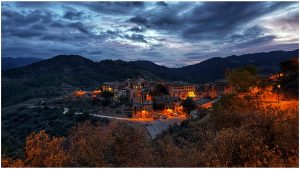 - This is one of the smaller towns located within the Priorat DOQ, it is physically almost in the centre of the Priorat DOQ and has a very small population (around 100 people!); there is NO convenience store and NO service station (petrol station) as well, with just 1 restaurant and an Marriott affiliate hotel of ORA Hotel Priorat (map) (which we stayed for 5 nights). This is a great location to stay if you are seriously going to different wineries each day due to the central location and lower commute time required if staying in the larger towns outside of Priorat DOQ. The ORA Hotel Priorat (which you can book on the Marriott Bonvoy app) provides breakfast and you can order dinner each night, which is usually the go-to option as there is only 1 restaurant in the town unless you drive to the neighbouring towns (which is tricky at night with all the switch back roads), the hotel has a large lounge area (covering the entire entrance ground floor) and also a full kitchen and balcony on the lower floor as well. Besides providing dinner you can also order wines from their cellar or via their “honor system” wine by the glass dispenser. Also the staff is great and very responsive on WhatsApp.
- This is one of the smaller towns located within the Priorat DOQ, it is physically almost in the centre of the Priorat DOQ and has a very small population (around 100 people!); there is NO convenience store and NO service station (petrol station) as well, with just 1 restaurant and an Marriott affiliate hotel of ORA Hotel Priorat (map) (which we stayed for 5 nights). This is a great location to stay if you are seriously going to different wineries each day due to the central location and lower commute time required if staying in the larger towns outside of Priorat DOQ. The ORA Hotel Priorat (which you can book on the Marriott Bonvoy app) provides breakfast and you can order dinner each night, which is usually the go-to option as there is only 1 restaurant in the town unless you drive to the neighbouring towns (which is tricky at night with all the switch back roads), the hotel has a large lounge area (covering the entire entrance ground floor) and also a full kitchen and balcony on the lower floor as well. Besides providing dinner you can also order wines from their cellar or via their “honor system” wine by the glass dispenser. Also the staff is great and very responsive on WhatsApp. - Falset - This is one of the larger towns just outside of the Priorat DOQ with a supermarket, convenience stores and service station. There are restaurants and hotels too (we noted this hotel which we may stay next time: Priorat Aparthotel (map)), which makes it a good base for for you to explore Priorat DOQ if you do not want to stay in a small town with “nothing” to do at night. However the commute to the various wineries is further (especially when going to the ones in the northern part of Priorat DOQ). On one day where we didn’t do winery tours, we did spend a day in Falset to have lunch and explore the city, there is a museum sharing the Catalan history; a pleasant town to explore!
Restaurant
- Quatre Molins (Cornudella de Montsant) (map) -
 A One Star restaurant in the Michelin Guide (2025) nestled in one of the larger towns just outside of the Priorat DOQ boundary (“basin”). It is a set chef menu, it is expensive compared to the other restaurants in the area, but very reasonably priced for a restaurant of its quality and standing. Food and service is great, what you expect from a One Star Michelin restaurant, with a very engaging chef who is very hands on even in the service.
A One Star restaurant in the Michelin Guide (2025) nestled in one of the larger towns just outside of the Priorat DOQ boundary (“basin”). It is a set chef menu, it is expensive compared to the other restaurants in the area, but very reasonably priced for a restaurant of its quality and standing. Food and service is great, what you expect from a One Star Michelin restaurant, with a very engaging chef who is very hands on even in the service. - Brots Restaurant (Poboleda) (map) - A nice little restaurant in one of the smaller towns within Priorat DOQ; they offer both an À la carte and chef set menu option (we went for the chef set menu). His wife is a the wine maker and owner of En Números Vermells, but surprisingly he does not serve a lot of her wines!
- Brichs Restaurant (Falset) (map) - A higher end restaurant in the large town just outside of Priorat DOQ, good food, good service and well priced.
- Restaurant El Cairat (Falset) (map) - A great local little restaurant in the larger town just outside of Priorat DOQ, very homey from the ambience to the service to the food!
- Atavus (Gratallops) (map) -
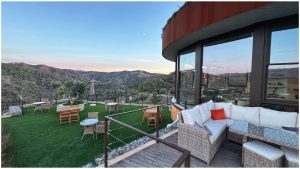 In one of the larger towns within the Priorat DOQ at the top of a steep slope which offer amazing view showing off the very unique terrain of Priorat. It is classified as an “wine bar” but they do serve more substantial dishes too.
In one of the larger towns within the Priorat DOQ at the top of a steep slope which offer amazing view showing off the very unique terrain of Priorat. It is classified as an “wine bar” but they do serve more substantial dishes too.
Additional Information
Depending on the time available and your objective, a suggested itinerary is to few days in Barcelona, then hiring a car (back) at Barcelona airport (as it is on the east side of the city) to head out Priorat. Even through the drive to Priorat is under 2 hours, you can break up the trip by staying overnight (or two) at Penedès to taste some Spanish sparkling wines (Cava) before continuing to Priorat DOQ, after which after stocking up on more wine heading back to Barcelona airport.
References
